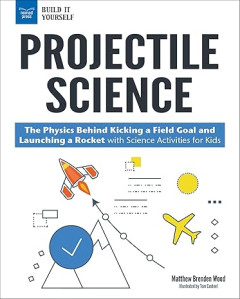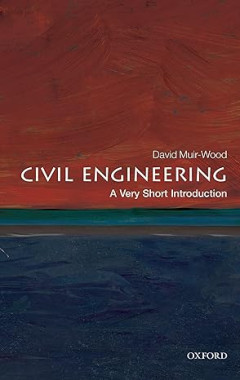Ditapis dengan

E-book Projectile Science: The Physics Behind Kicking a Field Goal and Launch…
What are the forces behind ballistics? Why do rocks and rockets soar through the air in an arch? The game is on the line. Suddenly, you hear the crack of a bat and the roar of crowd. Where will the ball land? How far will it travel? Is it a home run? You might think that hitting a home run or nailing a three-pointer is just luck, but there are many forces at work that determine if you’v…
- Edisi
- -
- ISBN/ISSN
- 9781619306783
- Deskripsi Fisik
- 198 halaman, ilus.
- Judul Seri
- -
- No. Panggil
- 530 WOO p
E-book Excavations at Chester : Roman Land Division and a Probable Villa in t…
The former Saighton Camp (centred on NGR SJ 4290 6420) was built for training by the British Army just prior to the start of the Second World War. The camp was located on the plain to the west of the mid-Cheshire ridge, to the east of the River Dee and to the south of Huntington village, separated from the latter by the A55 (Figure 1). It remained in use by …
- Edisi
- -
- ISBN/ISSN
- 9781803272283
- Deskripsi Fisik
- 114 hlm
- Judul Seri
- -
- No. Panggil
- 930.1 WOO e
E-book Compartment Syndrome : A Guide to Diagnosis and Management
The diagnosis and management of compartment syndrome represents a dilemma for clinicians. A major cause of concern in treating compartment syndrome is the potentially devastating outcome if not treated effectively. Compartment syndrome results in ischemia within a fascial compartment that eventuates into necrosis of the tissues it encompasses. Sequelae of missed compartment syndrome include los…
- Edisi
- -
- ISBN/ISSN
- 9783030223311
- Deskripsi Fisik
- 186 hlm
- Judul Seri
- -
- No. Panggil
- 617.47 AIY c
E-book Educational Resource Management : An international perspective
Educational resource management is a fascinating area of study because there is such a wide variety of practice, not only between developed and developing countries but also between countries that have similar living standards. The importance a country attaches to education is reflected in the proportion of the Gross Domestic Product (GDP) it spends on primary and secondary education. In 2017 t…
- Edisi
- -
- ISBN/ISSN
- 9781787358386
- Deskripsi Fisik
- 197 hlm
- Judul Seri
- -
- No. Panggil
- 370.2 GLO e
E-book Business School Internationalisation in a Changing World
This is the Open Access edition of Global Focus from the European Foundation for Management Development (EFMD). Global Focus has become one of the most authoritative resources for in-depth analysis and updates on international management development. With features, topical reports, thought leadership and insight from leading experts from academia, business schools, companies and consultancies, …
- Edisi
- -
- ISBN/ISSN
- 9781003500629
- Deskripsi Fisik
- 146 hlm
- Judul Seri
- -
- No. Panggil
- 330.12 WOO b
E-book Reasons and Persons
This book challenges, with several powerful arguments, some of our deepest beliefs about rationality, morality, and personal identity. The author claims that we have a false view of our own nature; that it is often rational to act against our own best interests; that most of us have moral views that are directly self-defeating; and that, when we consider future generations the conclusions will …
- Edisi
- -
- ISBN/ISSN
- 978019824908X
- Deskripsi Fisik
- 560 halaman
- Judul Seri
- -
- No. Panggil
- 170.0 PAR r

E-book The Chemistry Book: From Gunpowder to Graphene, 250 Milestones in the …
From atoms and fluorescent pigments to sulfa drug synthesis and buckyballs, this lush and authoritative chronology presents 250 milestones in the world of chemistry. As the "central science" that bridges biology and physics, chemistry plays an important role in countless medical and technological advances. Covering entertaining stories and unexpected applications, chemist and journalist Derek B…
- Edisi
- -
- ISBN/ISSN
- 9781454917281
- Deskripsi Fisik
- 811 halaman, ilus.
- Judul Seri
- -
- No. Panggil
- 540 LOW t

E-book Civil Engineering: A Very Short Introduction
Civil engineering has made an inestimable contribution to modern life, providing the crucial expertise behind our vast transportation systems and the wide array of built structures where we work, study, and play. In this Very Short Introduction, engineer David Muir Wood turns a spotlight on a field that we often take for granted. He sheds light on the nature and importance of civil engineering …
- Edisi
- -
- ISBN/ISSN
- 9780199578634
- Deskripsi Fisik
- 309 halaman
- Judul Seri
- -
- No. Panggil
- 624 WOO c

E-book Film: A Very Short Introduction
Film is arguably the dominant art form of the twentieth century. In this Very Short Introduction, Michael Wood offers a wealth of insight into the nature of film, considering its role and impact on society as well as its future in the digital age. As Wood notes, film is many things, but it has become above all a means of telling stories through images and sounds. The stories are often quite fal…
- Edisi
- -
- ISBN/ISSN
- 9780192803535
- Deskripsi Fisik
- 290 halaman, ilus.
- Judul Seri
- -
- No. Panggil
- 791.4375

E-book Human Evolution: A Very Short Introduction
The recent discovery of the diminutive Homo floresiensis (nicknamed "the Hobbit") in Indonesia has sparked new interest in the study of human evolution. In this Very Short Introduction, renowned evolutionary scholar Bernard Wood traces the history of paleoanthropology from its beginnings in the eighteenth century to today's latest fossil finds. Along the way we are introduced to the lively cast…
- Edisi
- -
- ISBN/ISSN
- 9780192803603
- Deskripsi Fisik
- 145 halaman
- Judul Seri
- -
- No. Panggil
- 576.8 WOO h
 Karya Umum
Karya Umum  Filsafat
Filsafat  Agama
Agama  Ilmu-ilmu Sosial
Ilmu-ilmu Sosial  Bahasa
Bahasa  Ilmu-ilmu Murni
Ilmu-ilmu Murni  Ilmu-ilmu Terapan
Ilmu-ilmu Terapan  Kesenian, Hiburan, dan Olahraga
Kesenian, Hiburan, dan Olahraga  Kesusastraan
Kesusastraan  Geografi dan Sejarah
Geografi dan Sejarah